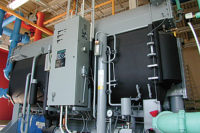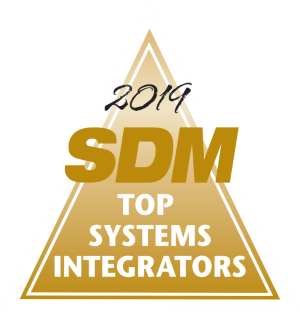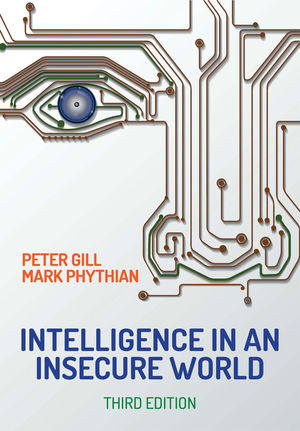The equation 1+1=2 is simple. It is one of the first concepts learned in math. But it is not as straightforward as it would seem, really. The proof for 1+1=2 is more than 300 pages long and it wasn’t conclusively proven until the 20th century by Bertrand Russell. Likewise, building automation systems (BAS) are a very complex manifestation of a simple principle: control. Mastering that complexity takes time, planning and intention for integrators choosing to offer BAS. SDMspoke with several leading integrators about their experiences with BAS, asking about how they are finding success, any stumbling blocks to avoid, resources needed, profit opportunities and more.
Although the concept of building automation has been in existence for a long time, growing awareness, new technologies, and a demand for energy-efficient buildings and enhanced security are driving the BAS market forward and creating new opportunities for integrators.
“Customers and engineers are starting to see the benefits of truly integrated building solutions. Anyone can plug disparate control panels into the same network switch, but few can provide a holistically integrated solution that leverages the individual capabilities of those disparate control panels to build a system that secures a facility and protects its occupants — but also keeps them comfortable while saving energy at the same time,” observes Steven Turney, security program manager at Carrollton, Texas-based Schneider Electric. Customers benefit from reduced installation and support costs as well as an increased flow of information that allows them to make more informed decisions, he adds.
By managing various building systems, the automation system ensures the operational performance of the facility as well as the comfort and safety of building occupants. But it takes time and training to design, install and maintain such a complex system.
Every integrator offering BAS has taken a different path to get there, whether through partnerships, acquisition, staff hiring/training, or another route. There is no silver bullet, and every integrator must carefully weigh what works for his or her unique company. Advantech Inc., located in Dover, Del., forged into BAS about eight years ago when it recognized that there was not a suitable product for its end users to easily manage and control the security systems for large facilities. This was especially true for facilities management and custodial staff, who didn’t have access to control rooms or security equipment, shares Eric Schaeffer, the company’s president and this month’s cover subject.
Today, Advantech has developed its own customer GUIs and command stations that serve as an intuitive interface for building and facility management. The company is also a Honeywell Integrated Security (HIS) National Dealer of the Year for 2008, 2010 and 2011, utilizing the Pro-Watch Integration Program, enables integrators and end users of the program to integrate security with building, industrial or enterprise systems, using an open architecture platform.
For its first project, the company worked with a high school to develop a customer touch screen controlled graphical user interface (GUI), multiple system integration, and more. But it used the expertise of its current staff, who Schaeffer says had the drive to be successful in developing new solutions for the customer’s challenges.
The initial team included Dave Sweeney, director of sales, and John Gampp, director of system support. “Their focus on testing and validating in our test lab prior to customer deployment has made our projects move smoothly and successfully,” Schaeffer says. “Since then we have trained additional existing employees and have also added staff with strong networking and IT skills. A little over a year ago we also hired a sales engineer, Frank Yoder, with more than 20 years in the BAS industry.”
“After this initial project we started adding more functionality into the GUIs. We also started deploying these solutions in other vertical markets,” Schaeffer shares. “Initially, the primary focus was on security, but as the capabilities increased these solutions became more and more valuable for operations and facility management.
The interfaces Advantech designs greatly simplify control of multiple systems and functions creating significant efficiencies, which greatly reduce man-hours. Schaeffer estimates the efficiencies Avantech offers with its BAS often save customers 100 man-hours a month or more, a huge savings of time and resources. “In many applications the pay back can be achieved in a matter of months,” he says.
Other integrators use acquisitions to enter the field. It worked best for Draper, Utah-based Utah Yamas Controls, which acquired a local BAS integrator (see related article on page 67) and Chicago-based System Development Integration LLC (SDI), which acquired i-sys, Charleston, S.C., a veteran BAS provider (see related article on page 64).
In addition to acquisitions, establishing relationships with the key vendors and providing training opportunities to the staff to educate them about the products, capabilities and features is a key to success, advises Denny Stover, executive vice president, San Diego and Northern California, Universal Protection Security Systems, Santa Ana, Calif. “It takes patience and finding the right partners and the right products to create the right solution, he adds. “You can’t take any shortcuts in this industry,” he told SDM.
Major BAS Industry Drivers
Operational costs savings and energy efficiency are major drivers of BAS installations and retrofits.
Industry surveys have determined that building owners and managers are realizing the many financial benefits of intelligent technologies, such as lower energy costs, lower maintenance costs and lower repair and replacement costs, says Rawlson O’Neil King, communications director, Continental Automated Buildings Association (CABA), Ottawa, Ontario, Canada, an international not-for-profit industry association with more than 400 members dedicated to the advancement of intelligent home and intelligent building technologies.
“Energy costs represent about 30 percent of an office building’s total operating costs, providing enormous opportunity for building owners not only to reduce operating costs, but also to make significant improvements in the overall environmental performance of their properties. By changing energy management practices and instituting intelligent building technologies that enhance energy efficiency, building owners and managers can reduce energy consumption by up to 35 percent,” King estimates.
The ability to demonstrate the savings grabs end users’ interest more quickly.
“If you look at security in many phases, there are intangible benefits. Security systems meet insurance requirements, they provide protection for possible events, and the value, while real, is less tangible on what you get back from a building automation system that brings in some very measurable benefits. When the HVAC system is turned off or the lights are turned out after everyone has left for the day, you save a measurable amount of money,” explains Chris Koetsier, director, product marketing, Honeywell Security, Melville, N.Y. “You can show the savings. But one of the challenges for integrators actually is that building automation is a different sale. You are talking about a very objective model.”
In addition to the different sales model, there are regulations to master. Building automation is driven by regulation, especially in Europe and Japan, and this is growing in the United States. “While regulation is lower in North America right now due to the nature of our economy and the way the free market trumps government directives, this is changing. You will start to see more and more regulations grow that demand an increase in energy efficiency,” King says.
Mirroring the Home
The awareness and expectation for automation in general is growing, making building managers more receptive to BAS.
It’s important to remember that facility managers are consumers like the rest of us, says Alan Stoddard, senior director, marketing at Honeywell Security. “They go home and manage their lives with their smartphones. If they see that adding a smart thermostat to a security system saves money on their home electrical bills, then it would stand to reason they would want the same benefits and intuitive user experience for their buildings as well,” he adds.
Integrators are able to succeed in building automation by capitalizing on commercial property owners’ needs, empowering business owners to take control of their building systems, and helping commercial end users optimize their systems to save the most money over time, Stoddard says. “Much like we’re seeing in the connected home space, security technology is ideal to serve as the core for these types of building systems because it knows when the building is occupied, who is in the building, and where they are within the facility.”
BAS By Numbers
Between rising energy costs, looming regulations and automation awareness, the numbers predicted for BAS growth are impressive, making the efforts of mastering the offering easier to accept.
The U.S. market for building automation equipment is set to grow by more than 40 percent within a five-year period ending in 2017, spurred by the need in commercial buildings for more efficient energy consumption, according to a report from IHS Inc. released in late 2013. Solid growth ranging from 7 to 9 percent is expected in the next four years, with industry revenue forecast to hit $2.24 billion by 2017, equivalent to a 43 percent increase from 2012.
Research and Markets predicts that the market for global intelligent building automation technologies will increase to $74.8 billion by 2019. Among all the technologies discussed, energy management technologies are registering a high growth rate followed by emergency response and commercial lighting control. North America is leading the global intelligent building automation technologies market with a share of more than 40 percent in 2014, followed by Europe.
The spiraling cost of electricity is a major factor in the operational efficiency of a commercial building structure, which explains why building automation systems could play an important role.
“With budgets cut and many large companies struggling to grow at more than 5 percent on an annual basis, the higher cost of electricity could prove to be a major headache for commercial and government building owners,” said Sam Grinter, market analyst for the Building Technologies group at IHS. “Making buildings as efficient as possible is crucial to driving down energy consumption. And one way to increase energy efficiency is to install an integrated building automation system,” he says.
BAS solves myriad end user needs, which attracts more integrators to it in order to provide a comprehensive, needs-focused solution. Also, while the integration and control possibilities do continue to grow more complex, technology developments such as wireless and auto-discovery IP devices are providing a counterbalance, allowing more companies into the arena.
BAS knowledge once seemed to be the exclusive domain of the ‘wizard-behind-the-curtain,’ but those days are long gone,” says Kevin McKeegan, building operations manager, SDI. More integrators are successfully learning what really makes 1+1=2. n
SDM speaks with Bruce Michelson, president, CM3 Building Solutions Inc., Fort Washington, Pa., an InsideIQ Building Automation Alliance member.
As a security integrator, how and when did you get started providing building automation?
Michelson: We have always been in the building automation business, and entered the security sector about five years ago. We entered the security sector because products became available to us and we saw an opportunity to offer more comprehensive integrated solutions to our clients. Since we entered the security sector we have seen exponential growth on an annual basis.
What are the opportunities as you see them for offering BAS solutions?
Michelson: There is no doubt that the ability to make a building operate automatically in its most efficient, safe, and comfortable state is desirable to owners, operators and tenants. The key is to deliver the proper level of automation within a budget where the financial and functional gains outweigh the costs.
How did your company gain the needed skills and knowledge for selling into this market?
Michelson: We simply hired the right people. We found that it was unrealistic to expect our building automation personnel, who had little or no experience in the security sector, to be capable of providing the right solutions to meet the needs of our customers. We sold a couple of jobs that didn’t do very well, so we changed course and hired personnel who had years of dedicated security sector experience. That’s when our business turned around and began to grow very rapidly.
SDM speaks with Advantech’s BAS team.
How did your company gain the needed skills and knowledge for selling into this market?
Eric Schaeffer: Advantech has and continues to do small- to medium-sized projects that include lighting control and other energy management control such as temperature. This background provided a baseline skill set, making the transition to more sophisticated BMS easier. From the beginning our core technical staff already had strong IT skill sets as well as experience in mapping and writing integration between security systems. We also had experience in automatic data transfer between systems. We developed manufacturer relationships and the certifications and training in products required to provide automation solutions. This includes InduSoft and their InduSoft Web studio software, and Omron and its PLC products. These provide the interface for mechanical and electronic automation.
Please describe the revenue and profit opportunities.
Frank Yoder: We have a large untapped, existing customer database that can realize additional ROI. When you refer to professional services, the design, programming and implementation of a system that offers a qualified and visible ROI, you can negotiate rather than bid. When designing applications that can constantly evolve to provide additional efficiencies it is important not to have a static view of the current needs and operation. The bid world boxes bidders into that mindset, as cost is the deciding factor, not the return on investment.
What are some of the pitfalls when entering this market?
Dave Sweeney: Our sales and engineering staff have had to account for significantly more pre-engineering and programming of projects. It is not uncommon for multiple weeks of pre-programming to be required for these projects. In fact, the largest learning curve for Advantech has been understanding and properly estimating required professional services and labor. We have also experienced a few challenges integrating into different systems that we have not typically integrated with.
Please describe a recent project.
John Gamp: A BAS project by Advantech at the Port of Wilmington integrates camera call up for more than 200 cameras, along with salvo control and automatic salvo switching with Maxpro VMS. The system integrates alarm information from perimeter fence detection and video analytics, while a custom GUI (shown at right) built on a map view of the port [which is 300 acres] provides the opportunity for users such as Gerardo Hernandez, security supervisor for the Port of Wilmington (pictured), to “drill down” into buildings and warehouses.
SDM speaks with Frank Rotello, president of the InsideIQ Building Automation Alliance, and CEO of Alpha Controls & Services, Rockford, Ill. InsideIQ Building Automation Alliance is an international alliance of independent building automation contractors representing common automation and security system platforms.
What are the opportunities as you see them for offering BAS solutions?
Rotello:Market drivers are based on increasing owner interests, industry trends, and emerging technologies leveraging the Internet and the building IT infrastructure. Integrators have an opportunity to ride the wave of BAS, but need to be ready and prepared to invest in their business to make sure they protect their customer base and are ready when new customer opportunities arise in their local markets. It starts with a commitment and willingness to get engaged, assign the right resources, develop a plan and invest in building a team and organization that is focused on delivering solutions for their customers.
Please describe the revenue and profit opportunities.
Rotello:First, the integrator serves as a resource to help the facility owner establish the building’s needs and serves on the team that is assembled to determine the best solution to be deployed. Establishing ongoing relationships with customers and partnering with them is where the revenue is built. These are complicated projects and the real success is based on how well an integrator can keep the building functioning over time. The systems integrator must become a trusted advisor, solutions provider and a strategic advisor for the facility owner.
SDM speaks with Kevin McKeegan, System Development Integration (SDI), Chicago.
As a security integrator, how and when did you get started providing building automation?
McKeegan: i-sys has delivered integrated BAS/security systems for more than 12 years. In 2013, SDI acquired i-sys, knowing that its building automation systems (BAS) and security business were a good fit with SDI’s other security and building solutions offerings. Synergies among customers and product applications — and the attraction of expanding the range of building solutions to the existing client base — made the integration of BAS into our service offerings a natural progression.
What are the opportunities as you see them for offering BAS solutions?
McKeegan: It is not insignificant that BAS, safety and security, and access control are all part of the convergence to IP networks in buildings, and that the data, trends, performance, efficiency and usefulness of these systems all become part of the body of information about a building. This technology trend will soon lay the foundation of unified IT network platforms.
Tremendous opportunity exists to make practical use of all this data from the Internet of Things in fresh ways: Access controls and video analytics can pinpoint building usage data to squeeze the most from utility spend through the BAS. Intelligent room controllers can be part of mass notification systems. Having a high IT IQ — from sales through its delivery organization — provides significant value in identifying potential areas of cost savings and security opportunities.
What are some of the pitfalls when entering this market?
McKeegan: In a construction environment, there is a potential risk of scope creep, because many parts of the total integrated BAS are provided by other suppliers and contractors, and successful integration to the BAS is not their priority.
When dealing directly with the client, the task of sorting all that out falls in our camp, and that’s where the application knowledge of the sales and estimators comes in to play. It is also key to know how you will transition a client to your service and support organization.
Please describe the revenue and profit opportunities.
McKeegan: There are many small BAS integrators in the $2 to $3 million annual revenue range, and a $15 to $20 million BAS operation in a good-size market is not unusual. Combining and integrating access, video, fire, metering, and other types of building services just multiplies the opportunity. With a good mix and good project management, consistent margins better than 10 percent are not unheard of.
SDMspeaks with Roy Stephenson, director of business development, Utah Yamas Controls, Draper, Utah, an InsideIQ Building Automation Alliance member.
As a security integrator, how and when did you get started providing building automation?
Stephenson: Utah Yamas Controls began selling security and access control systems back in 1995 with the acquisition of a local security company. Our largest building automation line at the time was I-Net from Control Systems International (CSI) and it offered integrated access control along with building automation.
What are the opportunities as you see them for offering BAS solutions?
Stephenson: As a building automation company that provides security, there are plenty of opportunities to increase your market share and branch out into a whole new market. If you are one of the select few companies that have the ability to actually implement an intelligent building management system, then you can reward your customers with lower operating expenditure and significant improvements in system operations and efficiency.
Please describe the revenue and profit opportunities.
Stephenson: In recent years, the switch towards IP-based security solutions has led to increased competition and lower margins due to the commoditization of the products. There is still money to be made doing security, but it is becoming more of a service-based industry with a focus on reccurring revenue and service contracts.
SDMspeaks with Jeremy Brecher, vice president, technology for Diebold Security, North Canton, Ohio
What skills and knowledge are needed for selling into this market?
Brecher: Building management systems require specialized training to understand the nuances between lighting, HVAC, elevator, escalator and other integrated systems. Compared to traditional low-voltage security systems, building management systems often require high-voltage wiring, which introduces additional risk, as well as additional training requirements. Security installation teams need to understand additional regulations related to UL ratings, engineering specifications, inspection protocols and life safety measures such that they can properly coordinate hand-off between teams installing different systems.
What are some of the pitfalls when entering this market?
Brecher: In terms of driving energy efficiency from smarter buildings, we’re careful to draw a distinction between managing energy versus reducing energy costs. Energy management solutions are naturally meant to reduce energy demands, but their primary benefit is their ability to better understand energy demands and consumption behaviors to drive intelligent management decisions. Actual energy savings begin once building managers determine how to best use the information gleaned from their energy management systems.
What are the opportunities as you see them for offering BAS solutions?
Brecher:Building managers should not assume that their building management and security system suppliers will be one in the same. This may work for smaller installations in which a security provider can provide holistic solutions, but for larger installations, building management and security are very separate tasks with specialized knowledge required in both arenas. It’s best to find appropriate partners on both sides and have them work together to deploy a truly integrated solution that meets the customers’ goals.
Integrated Controls for Perot Museum of Nature and Science Provide ‘Full Access’
Schneider Electric, a global specialist in energy management, successfully installed an entirely integrated control and security systems throughout the architecturally compelling Perot Museum of Nature and Science in Dallas. The customized system design enables the museum to perform at maximum efficiency and sustain its educational mission for patrons.
The highlight of the Perot Museum project is the integrated building management system (BMS). Schneider Electric incorporated its Andover Continuum™ solution for the BMS and access control systems, Pelco by Schneider Electric IP cameras and closed circuit television (CCTV), Stentofon IP intercom, Radionics [Interlogix] intrusion detection, and Notifier fire alarm.
“During the design phase, it was clear that the designers and owners wanted all systems in the facility to be viewable by those who would visit the museum. They wanted the systems in the facility to be as much of a teaching tool as the exhibits in the museum, so the Schneider Electric team integrated all the systems to allow the customer to have full access to the entire system from multiple locations,” describes Steven Turney, Schneider Electric.
The BMS also has remote capability, so it can be monitored and managed from anywhere. Besides creating a safe, secure environment for museum patrons and staff within this facility, the integrated system will allow the museum to run efficiently and effectively, significantly reducing both capital and operational expenditures.
“When running a nonprofit organization, efficiency is extremely important to our sustainability,” says Kenneth Cadenhead, director of facilities, Perot Museum of Nature and Science. “The savings we’ll earn from this project will ensure we are able to invest properly in educational programs and exhibits, giving our patrons the best possible experience at the Perot Museum.” Learn more at www.schneider-electric.com/us.
















